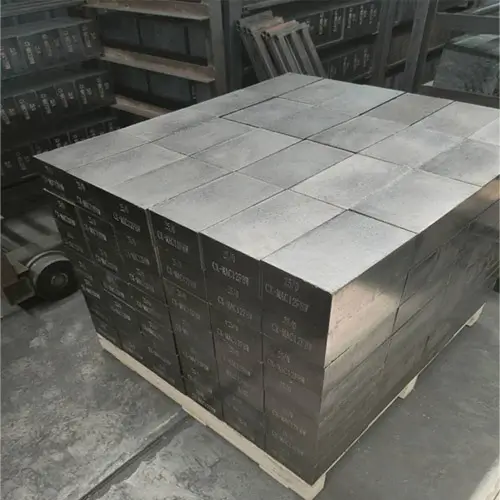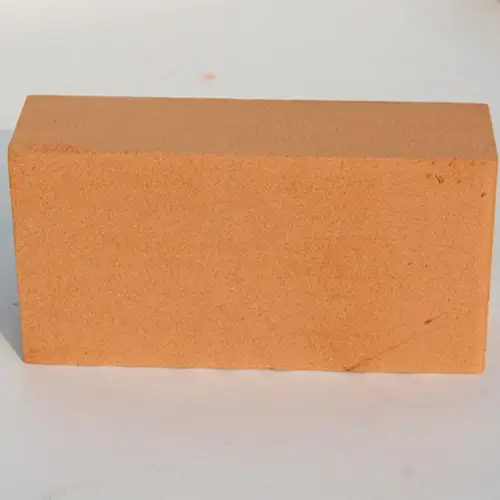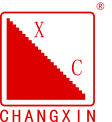Refractory materials belong to is a large piece of industrial goods, transportation, often using logistics, freight or rail transportation, and in the process of loading and unloading is not like treating glass, porcelain, etc. so careful, and generally will not have a special thickening of the soft packaging for protection, which inevitably leads to damage to the goods, broken. So, in the end, what kind of brick is called missing corners and edges, how large a diameter hole is considered a melting hole? How many mm is considered abnormal cracks? Bend to what angle is considered deformation? According to the national standard as well as the relevant information collated a detailed article on the refractory products inspection methods , for your reference.
1. Inspection of dimensions
- 1.Check the size, according to the provisions of the order drawings.
- 2.When measuring, the zero point of the steel ruler must be aligned with the prongs of the product, and a steel tape measure or steel ruler can be used. Measure the inner and outer diameters of the products, the use of tool calipers.
3.General products (in addition to special provisions), to measure the products on each side of the middle 1 / 3 part of the size shall prevail.
- 4.The measurement of the relative side of the product to measure the products of the same size of the relative difference between the two sides shall prevail. Product sub, mother caliber relative edge measurement, to measure the product of the same sub-mouth or mother mouth on the long and short axis of the difference shall prevail.
5.Where the tolerance value expressed as a percentage, the value should be calculated to the integer, the decimal point after the calculation of the “numerical modification rules” GB8170-87).
2.Inspection of melt holes
1.When checking the melting hole, it is allowed to use a small metal hammer to tap the surface of the product due to the melting of low-melting material and significant discoloration of the cavity, and then use a steel ruler to measure the maximum diameter of the melting hole.
2.Due to foreign such as wood chips, putty, cloth and other organic inclusions caused by the cavity, but also according to the melting hole inspection method for inspection, but the allowable value is not greater than the value of the melting hole of the product 1 times (for example: the melting hole of the value of the provisions of the 8mm, then the value of the hole is allowed to be not greater than 16mm).

3.Inspection of missing corners and edges
1.In-depth inspection method
(1) The depth of missing corners and edges is checked by using a specially manufactured protractor and protractor that can be tightly fitted on the corners of the product and has a scale that slides in the specified direction.
(2) the depth of the missing corner, for right-angled products, the use of cube-shaped goniometer, measured along the center of the cube diagonal direction; for non-right-angled products, the use of Mitsubishi body-shaped goniometer measured along the direction of the center line of the Mitsubishi body.
(3) The depth of the missing prongs is measured along the direction of the equidistant line of the angle between the two sides of the product to measure the deepest part of the missing prongs. If there is a length limitation, measure the full length of the defect at the same time.
(4) When missing corners and edges are connected, they are checked separately. The missing angle of the missing part of the angle is not calculated, that is, the missing part of the corner according to the missing corner of the provisions of the inspection, the missing part of the angle according to the missing part of the provisions of the inspection.
(5) In addition to special provisions, where the depth is greater than 3mm to the limit of the standard allowable value of the missing corners, missing edges, all participate in the calculation. 3mm and less than 3mm depth of the missing corners, missing edges are not as missing corners and edges.
2.Sum-of-three checks
Corners or edges are calculated as the sum of the three sides of the defect.
4. Inspection of cracks
- 1.For crack inspection, use a steel ruler with a scale of 0.5mm and a steel wire with a diameter equal to the width of the measured crack (e.g., 0.1, 0.25, 0.5, 1.0mm).
- 2.Check the crack, the natural insertion of steel wire into the widest part of the crack, but shall not be inserted into the naked eye visible particles off. Where 0.25mm steel wire can not be inserted into the crack, the width of <0.25mm said; where 0.25mm steel wire can be inserted and 0.5mm steel wire can not be inserted into the crack, the width of 0.26 ~ 0.5mm said; and so on.
- 3.Cracks are not straight, can be divided into line segments to measure, the sum of the length of the line segments for the total length of the crack. There are interruptions in the middle and the interruption distance is greater than 5mm cracks (including unrestricted cracks), that is, 1 crack, the length of the combined calculation, but the cross and parallel direction of the cracks, except.
- 4.Cracks across the prongs, in addition to special provisions, are calculated according to the continuous length of 1 crack across the working surface and non-working surface at the same time, are assessed according to the working surface (for example: a standard provides that the width of 0.26 ~ 0.5mm crack, the working surface should be no greater than 30mm, non-working surface should be no greater than 50mm. if the crack across the working surface and non-working surface at the same time, the continuous length of the assessment of the working surface should be no greater than 30mm). shall be not greater than 30mm). Cracks spanning two prongs at the corner, where the value does not exceed the range of values specified for the missing corner, shall not be calculated according to the spanning of two prongs. Where the standard provisions of the crack is not limited, are not subject to the restrictions across the prongs, and do not check.
- 5.There are grooves, tongue face, according to a face calculation, except for casting bricks; through holes in the face, according to the calculation of two faces.
- 6.Thin and long cracks formed due to improper cooling are sharp cold cracks (blow-up cracks) and should be treated as non-conforming products.
- 7.Where several cracks form a closed curve, that is, mesh cracks. Calculate the length of the mesh crack, to the full length of the perimeter shall prevail. Where more than one crack intersects, that is, cross-crack. When calculating the number of cross-cracks, the straight-line cracks through the intersection point shall prevail.
- 8.Greater than 120. Angle of the prongs, not to prong calculation, the size of the face less than 20mm wide, not to face calculation, but the casting of bricks with the exception of.
5. Checks for distortion
- 1.Twist and check with a plug rule made of sheet metal. The width of the tape is 10mm, and the thickness is 0.1mm larger than the permissible limit specified in the standard (e.g. 1.6, 2.1, 2.6, 3.1, 3.6mm, etc.).
- 2.When checking the distortion, put the inspected surface of the product on the flat plate (the area of this plate should be larger than the surface of the product to be inspected) and keep it naturally smooth. Then insert the tape measure smoothly along the surface of the plate into the maximum gap between the plate and the product, the depth of insertion of the tape measure does not exceed 10mm is qualified.
- 3.The indentation is checked according to the distortion method.
6.Inspection of end plane tilt
- 1.For checking the inclination of the end plane, use a right-angle steel ruler with a side length of 220min×220mm, and a metal stopper with a width of 5mm and a thickness of 0.1mm greater than the permissible limit stipulated in the standard (e.g., when checking the inclination of the end plane of 2.0mm, use a stopper with a thickness of 2.1mm).
- 2.Check one side of the right-angle steel ruler and the longitudinal surface of the product in close contact with the same time so that the other side of the right-angle steel ruler is close to the end, and then the plug rule along the right-angle steel ruler and the end of the gap between the formation of smooth insertion to the provisions of the rule can not be inserted into the person as a pass.
7.Inspection of slagging
- 1.All due to the firing of fuel ash and products combined with the surface of the glassy buildup; due to other impurities and products on the surface of the chemical change, so that the surface of the product is eroded and produced by the melting discoloration, collectively referred to as slag erosion.
- 2.After processing and smoothing, no significant pitting and erosion of products, not to slag corrosion.
8.Inspection of raw burnt products
- 1.Where the same raw materials, the same process of production of products, after firing the appearance of color and normal production of products with a significantly different size expansion and contraction of insufficient, open section of the particles is significantly open without breaking, then the products should be examined when the firing situation.
- 2.The judgment of raw burnt products shall be based on the identification of physical properties.
- 3.The raw burnt products shall be treated as substandard products.

9.Inspection of cross-sections
- 1.All products produced by the molding of the delamination and cross-section of the seam layer of tissue, that is, for the cross-section of the layer of cracks. Product section with a hammer and steel chisel in the perpendicular to the length of the product molding compression surface and take. The inspection of cross-section layer crack according to this section four.
- 2.Since the products produced by the firing of local significant discoloration, such as black and red, that is, black heart or red heart. Products with black heart or red heart is judged to be substandard (Al ₂ O ₃ ≥ 75% of the high alumina bricks due to high temperature, the atmosphere caused by the black heart is excluded).
10.Inspection of the regularity of the shape of plug bricks and casting mouth bricks
- 1.Plug the head of the brick shape of the degree of regularity of the inspection, the use of supporting casting mouth brick, will be placed on the supporting casting head of the brick, gently pressed by hand, and make the head of the brick along the center axis of rotation for a week. Where the plug head brick on the abrasion marks were uninterrupted continuous ring for qualified products.
- 2.Casting the degree of regularity of the shape of the brick, the use of matching plug head brick, matching plug head brick on the casting of the brick, gently pressed by hand, and make the plug head brick along the center axis of rotation for a week. Where the casting of the mouth of the brick on the abrasion marks were uninterrupted continuous ring for the qualified products.
- 3.Arbitration, the standard cast mouth brick model or standard plug head brick model shall prevail.
11.Inspection of working and non-working surfaces
- 1.Where the drawings indicate the work surface on the product, all the standard work surface according to the work surface inspection. Not specify the working surface of all non-working surface inspection.
- 2.The corners connected with the work surface, all according to the provisions of the work surface inspection.
